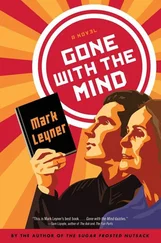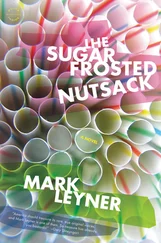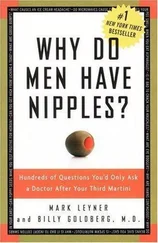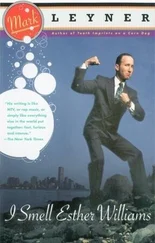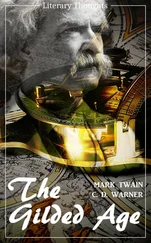Teenage Neofascist Skinheads Suffering From Progeria (That Rare Premature Aging Disease) Play Mah-Jongg at a Swim Club in Lake Hayden, Idaho is a 94-by-66-inch, acrylic-on-canvas work that, notwithstanding a title that leads one to expect several freakishly wizened nazi youths wanly shuffling mah-jongg tiles outside a lakefront cabana, actually depicts, in delicate flecks of color, several peonies in a vase.
Anna Nicole Smith Before and After Fire-Ant Attack is a 90-by-120-inch acrylic-on-canvas diptych. In this case, the title does literally describe the painting’s content. In the left-hand panel, the former Texas checkout girl turned Guess? Jeans model is splayed lasciviously on a dirt road. The right-hand panel features the identical pose except that the lasciviously splayed Smith is stippled with hundreds of Seurat-like inflamed pustules.
Barbara Walters conducts a brief interview with Silvio, whose garbled responses are subtitled. In the closing minutes, wiping drool from his chin, she says, “Silvio, you completed only two paintings in your entire career, both of which you sold for a fraction of their current value [the paintings now hang in opium warlord Khun Sa’s splendid new museum in northern Myanmar] and then squandered the money on an endless succession of skanky male prostitutes. As a result of a frying pan and a body wax, you’ll never paint again. And your desperate attempt to reinvent your career as a movie director was an unmitigated critical and financial disaster.”
Barnes wrote and directed a film entitled ¡Hola Mami! about an eccentric middle-aged optometrist who marries a sullen, zit-spangled 16-year-old who loiters around his office every day after school, chain-smoking in a fuchsia PVC bustier, a huge gaudy crucifix bobbing on her bosom. The “plot” revolves around the optometrist’s use of a varietal rice chart instead of the traditional lettered eye chart. Long, uninterrupted stretches of the movie consist of the following sort of dialogue:
OPTOMETRIST: Let’s start with the top row, moving from left to right.
PATIENT: All right. Arborio. Valencia. Lundberg’s Christmas Rice. Black Japonica. And Wehani.
OPTOMETRIST: Perfect. Second row.
PATIENT: Red. Sri Lankan Red. Wild Pecan. Jasmine. White Basmati.
OPTOMETRIST: Perfect. Let’s skip down a few rows. How about row five?
PATIENT: American White Basmati. American … Umm … American Brown Basmati, I think. Maratello. And that next one’s either Black Sticky or Thai Sticky. And I’m not sure about the last one.
OPTOMETRIST: OK. How about the next row down, row six?
PATIENT: That’s really tough. Converted? Sambal? Gobind Bhog? They’re really fuzzy.
OPTOMETRIST: OK. Back up to the fourth row—
PATIENT: Japanese Sticky. Sticky Brown. Short-Grain Brown. Long-Grain White. And Wild Rice.
OPTOMETRIST: Is row six sharper now or … now?
PATIENT: The first way.
Following the clip from ¡Hola Mami! they cut to Hugh Downs and Barbara Walters back in the studio.
And Walters says with her patented withering aplomb, “Hugh, in all our years together on the show, we’ve profiled so many wonderful people whose lives have been shattered by tragedy, but I’ve never before come away with the feeling that — hey, this guy is such an overweening, self-absorbed asshole, he deserves his misfortune, and, in fact, there’s something so divinely just about it, that it’s actually funny. It’s so rare that we can derive some cathartic enjoyment from another person’s suffering. But every so often our fervent prayers are answered and an obnoxious enfant terrible’s meteoric success is abruptly and irrevocably snuffed. Silvio Barnes — now blind, incapacitated, and anathema in New York and Hollywood — is an individual whose precipitous ruin all Americans can celebrate with big, hearty, guilt-free gales of laughter.”
And Hugh looks at Barbara and says, “Fascinating.”
As they break for a commercial, Felipe, Gretel, and I do an instant postmortem.
“I’m into Barbara’s rancid schadenfreude,” says Felipe.
“I hear you, dude,” I say. “It had wings. But Downs killed it with that perfunctory ‘Fascinating.’ ”
“Hugh’s hot!” objects Gretel.
“Yuuuk!” Felipe and I make the international sign for hemorrhagic vomiting.
“You’ll appreciate Hugh Downs when you’re more mature,” she says, haughtily readjusting her brassiere.
“I don’t think I’ll ever be that mature,” I say, huffing glue from a brown paper bag and passing it back to Felipe.
All of this — the warden escorting me into the witness room, the momentary glimpse of the slope of her breast, possibly her areola, and the flesh of her armpit as she sits down, and then the frenzied search through my memory for just the right 20/20 segment to temporarily neuter myself so that a healthy, perfectly normal, and involuntary heterosexual reflex won’t be misinterpreted in such a way that I’m seen as an execrable son — all of this takes place in a span of no more than ten seconds. I wonder if, like, Bill Gates when he was 13, had the ability that I have at the age of 13 to anatomize minute fluctuations of consciousness that are occurring literally in femtoseconds. Anyway …
It’s 5:25 P.M. Appeals exhausted, reprieves forsaken, last words ardently orated, the execution of Joel Leyner C.P. #39 6E-18 commences.
Inside the control module room, the executioner activates the delivery sequence by pushing a button on the control panel. A series of lights on the panel indicates the three stages of each injection: Armed (red), Start (yellow), and Complete (green).
As the lights for the initial injection sequence switch on and a piston is loosed from its cradle and falls onto the plunger of the first syringe, the delivery module introduces 15 cc of 2-percent sodium thiopental over ten seconds, which should cause unconsciousness.
I nudge the superintendent with my elbow.
“Thanks,” I whisper, returning his pen.
“Keep it,” he says.
“Are you kidding?”
“No. It’s yours.”
“Cool!” I gush.
After a minute, the red light pulses again, then the yellow, and the machine injects 15 cc of pancuronium bromide, a synthetic curare that should produce muscle paralysis and stop his breathing.
Following another one-minute interval, the lights flash and the final syringe, containing 15 cc of potassium chloride, is injected, which should induce cardiac arrest, with death following within two minutes.
Thirty seconds pass.
A minute.
In the dark witness room, we are mute and absolutely still. And in this riveted silence, the physiologic obbligato of human bodies — the sibilant nostrils, the tense clicking of temporomandibular joints, the bruits of carotid arteries, and the peristaltic rumblings of nervous bowels — becomes almost a din.
Ninety seconds elapse.
Two minutes.
The muscles in my father’s neck appear to become rigid, actually lifting his head slightly off the gurney.
His eyes open wide.
“I feel shitty,” he says.
The doctor, who’s been monitoring the EKG, frowns at the operations officer, who turns to the warden and shakes his head grimly. Scrutinizing an EKG printout incredulously, he emerges from behind the screen and approaches my dad. He checks his pupillary reflexes with a penlight and then listens to his respiration and heart with a stethoscope.
“Physically, he appears to be absolutely fine,” he says, grimacing with bewilderment.
The operations officer in turn gives a thumbs-down to the warden, who’s now risen from her seat in the witness room.
“Mr. Leyner,” says the doctor to my father, “I’m going to give you several statements and I want you to respond as best you can, all right?”
Читать дальше


